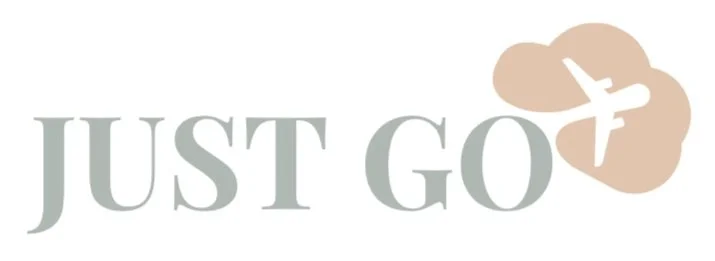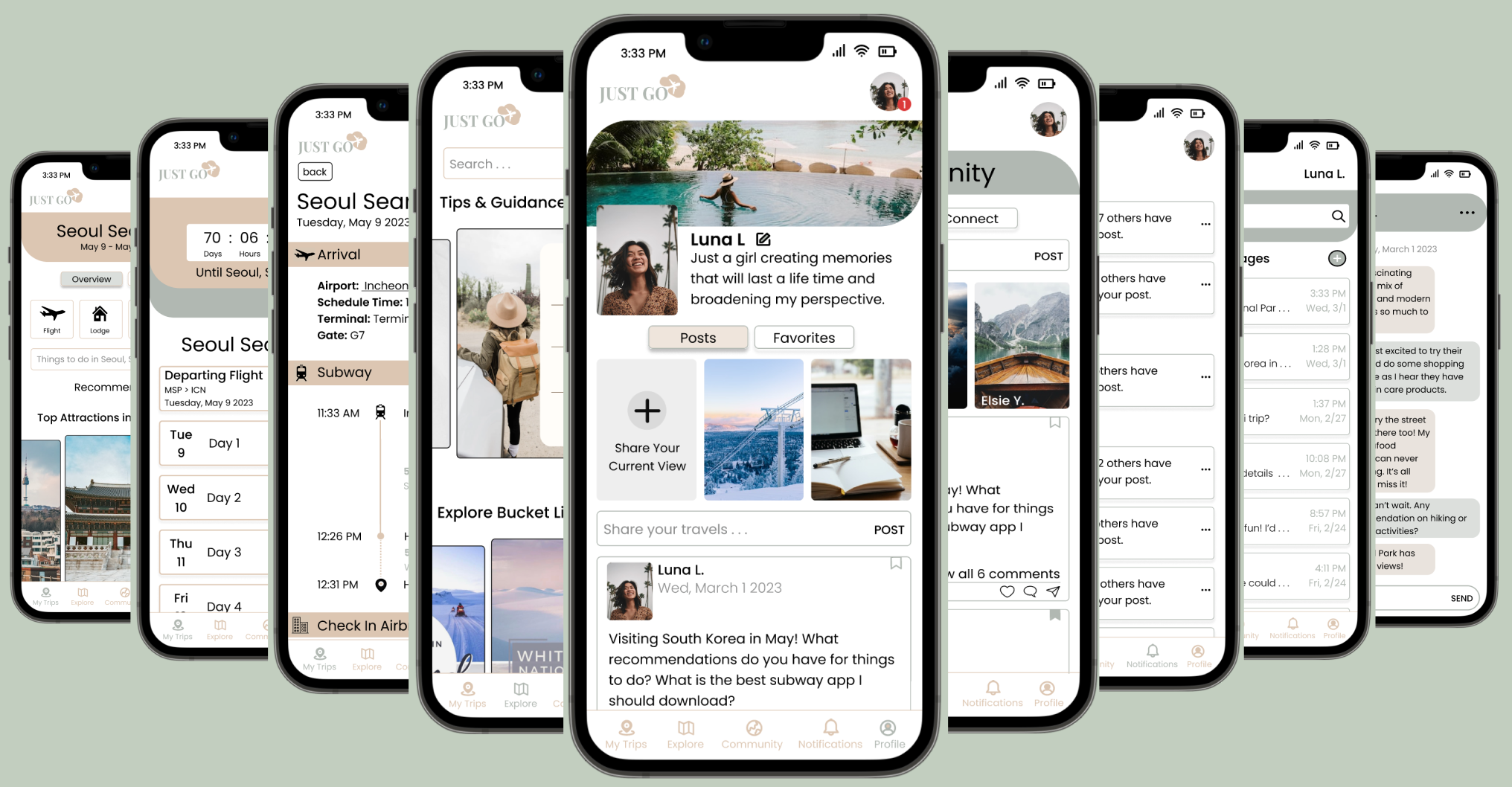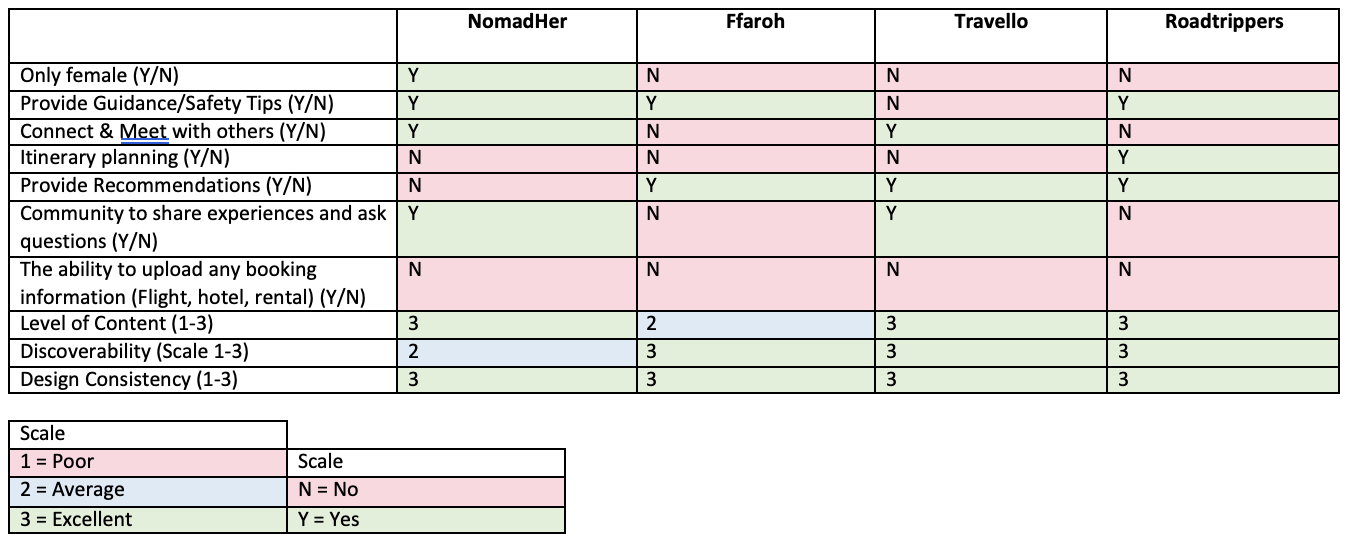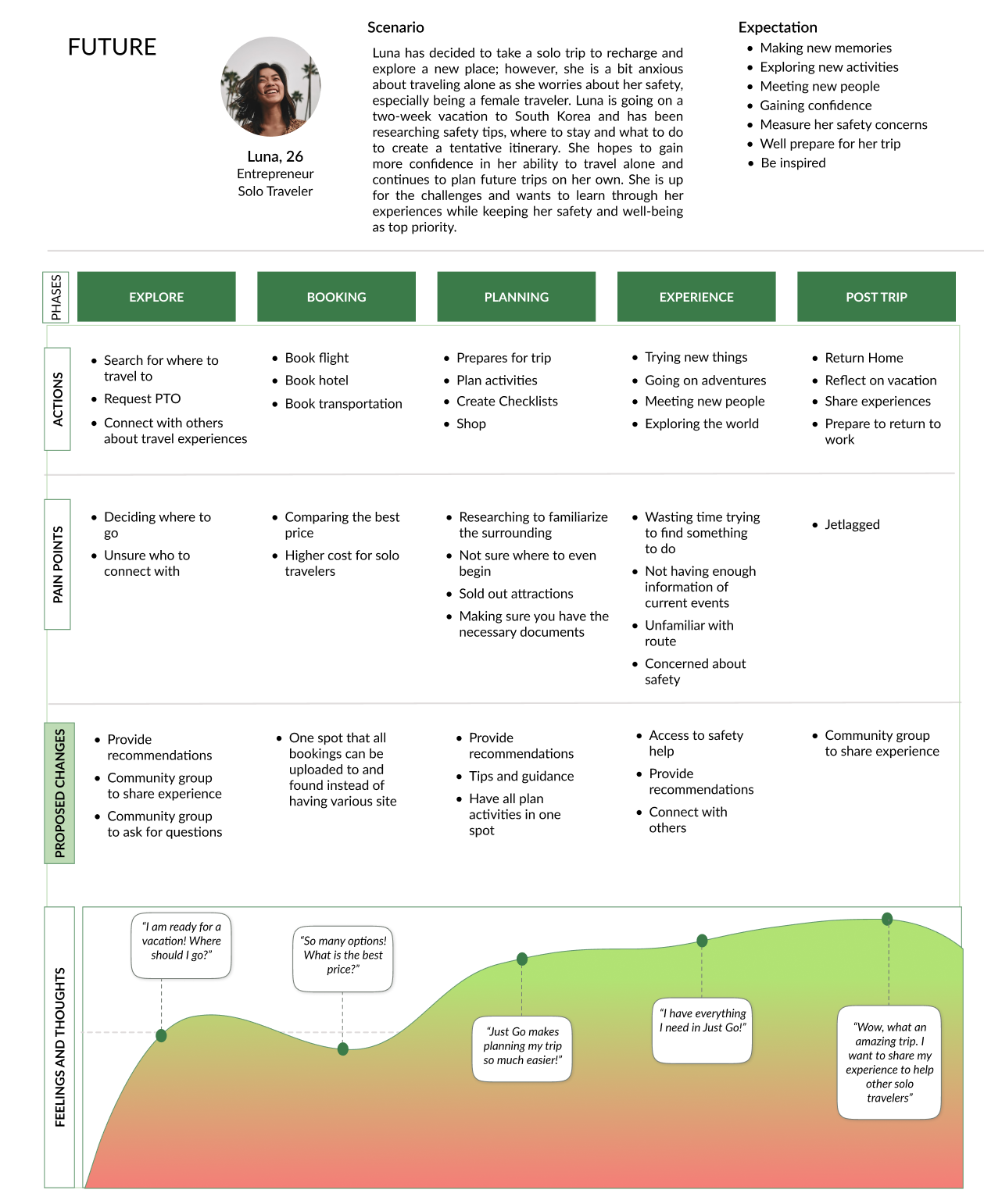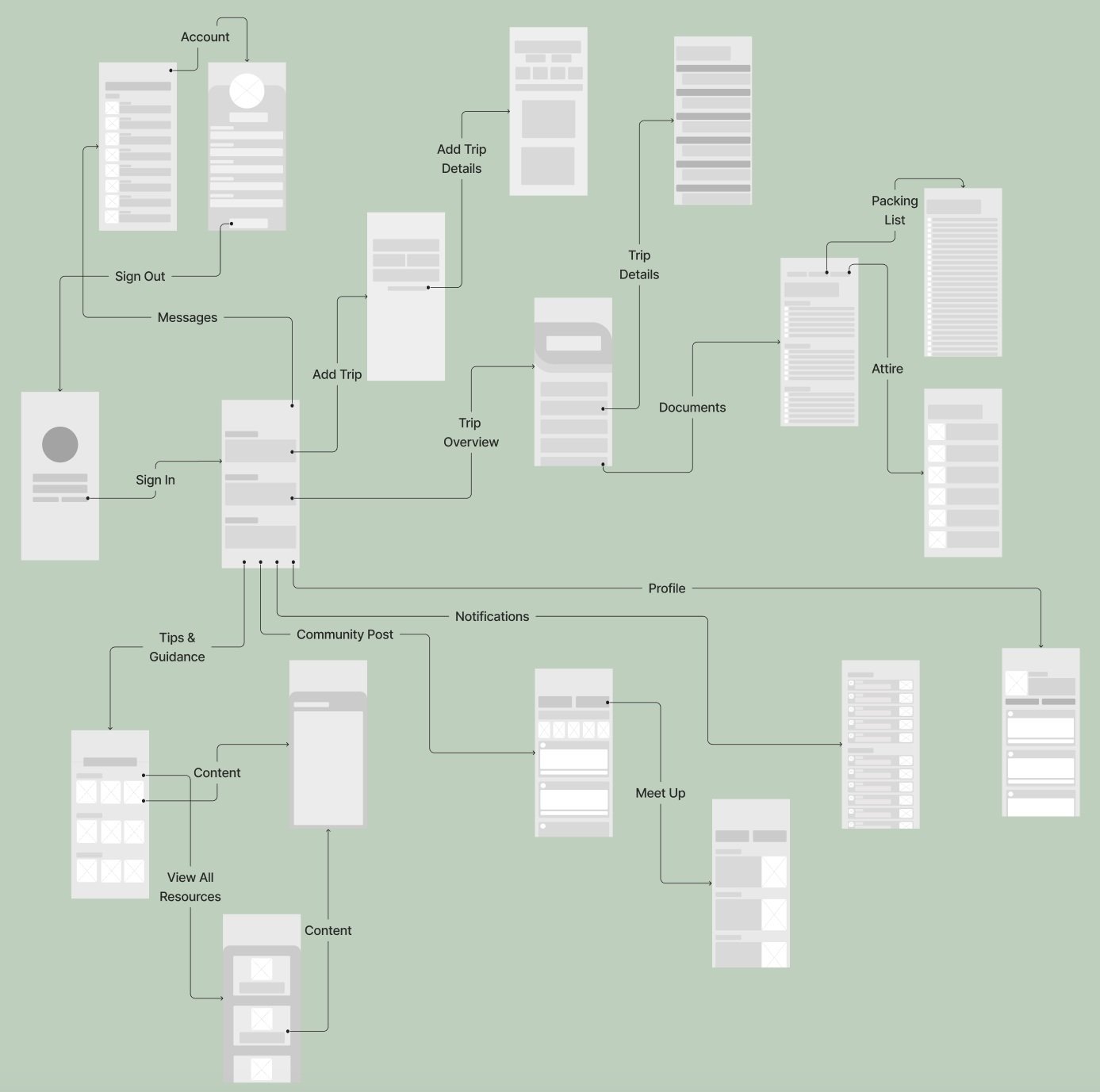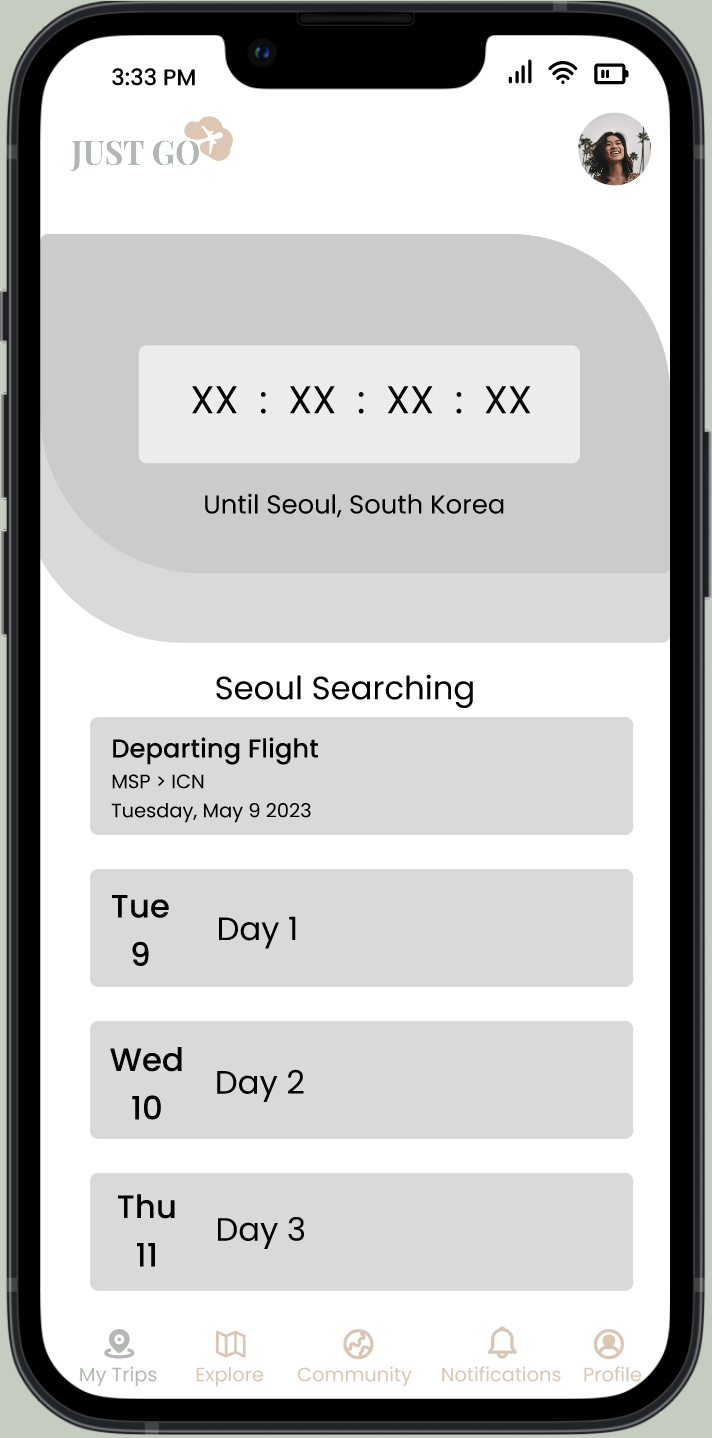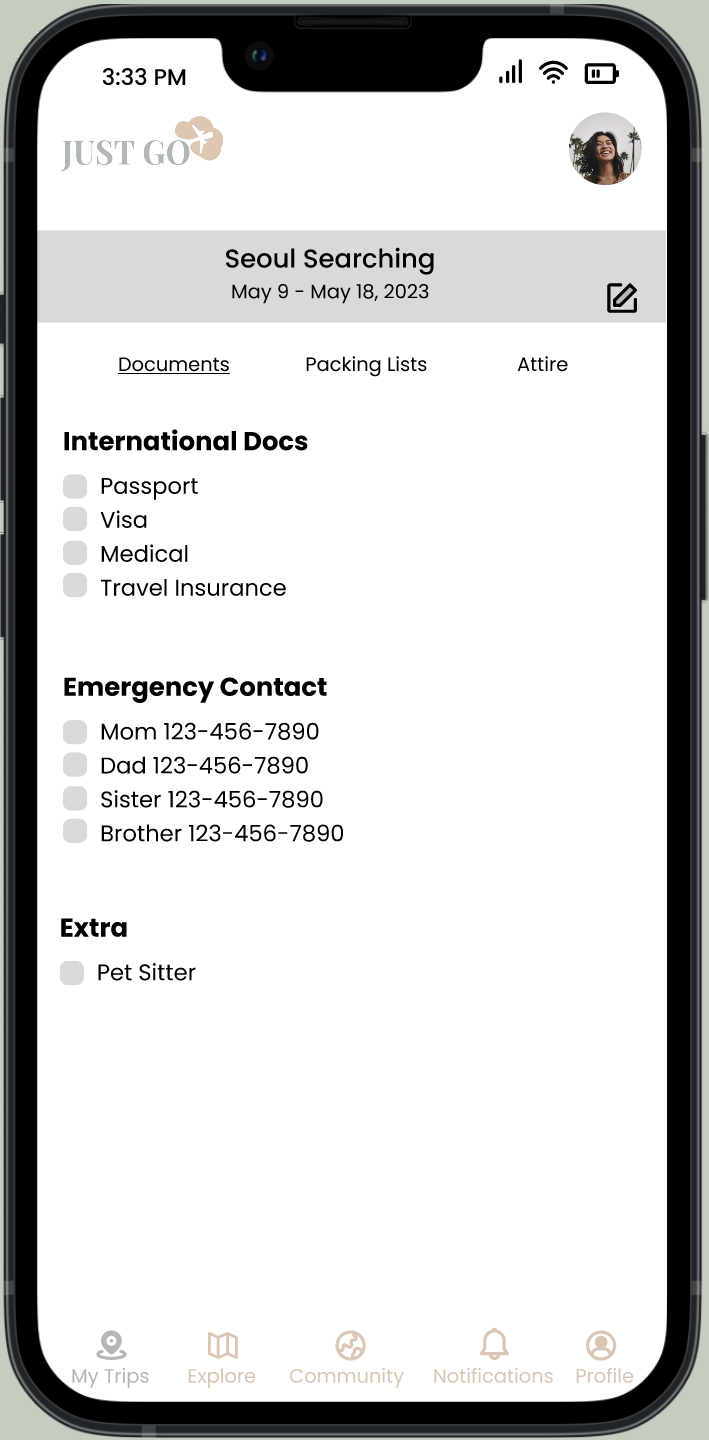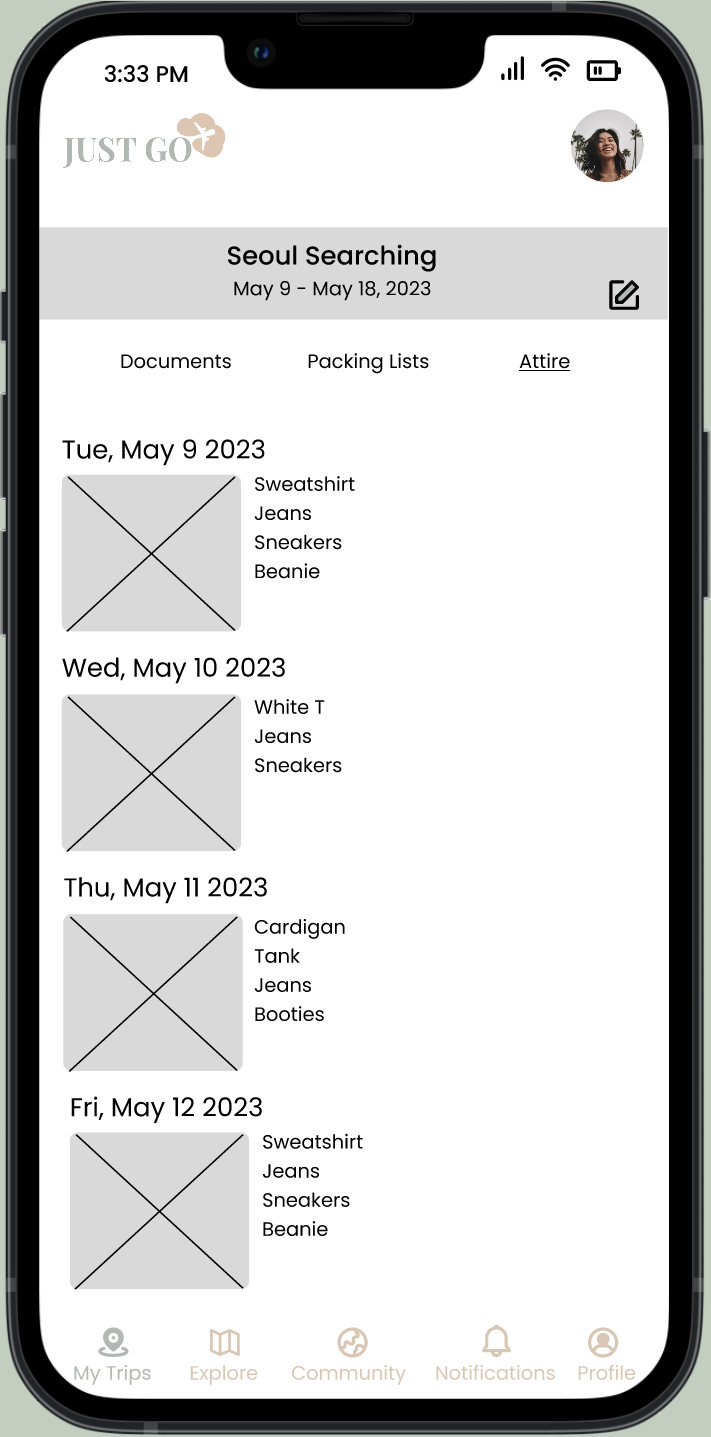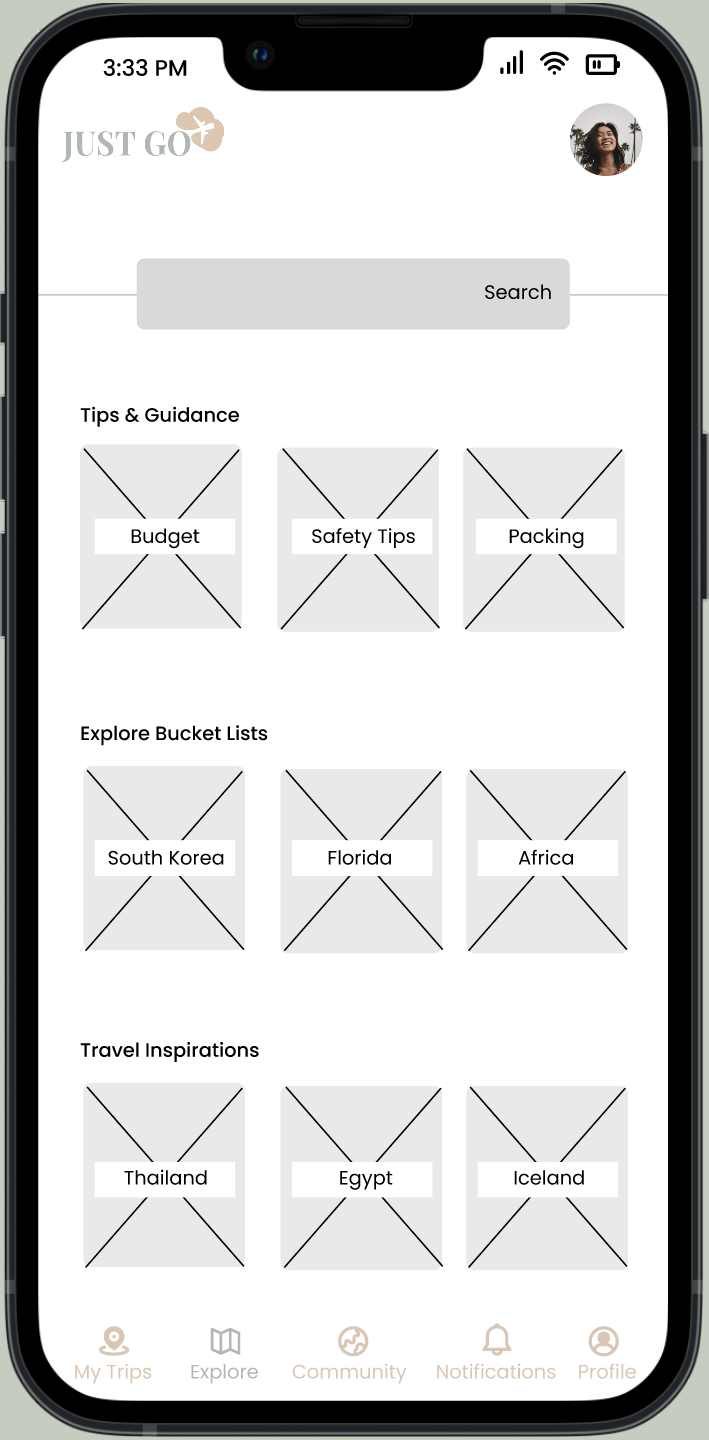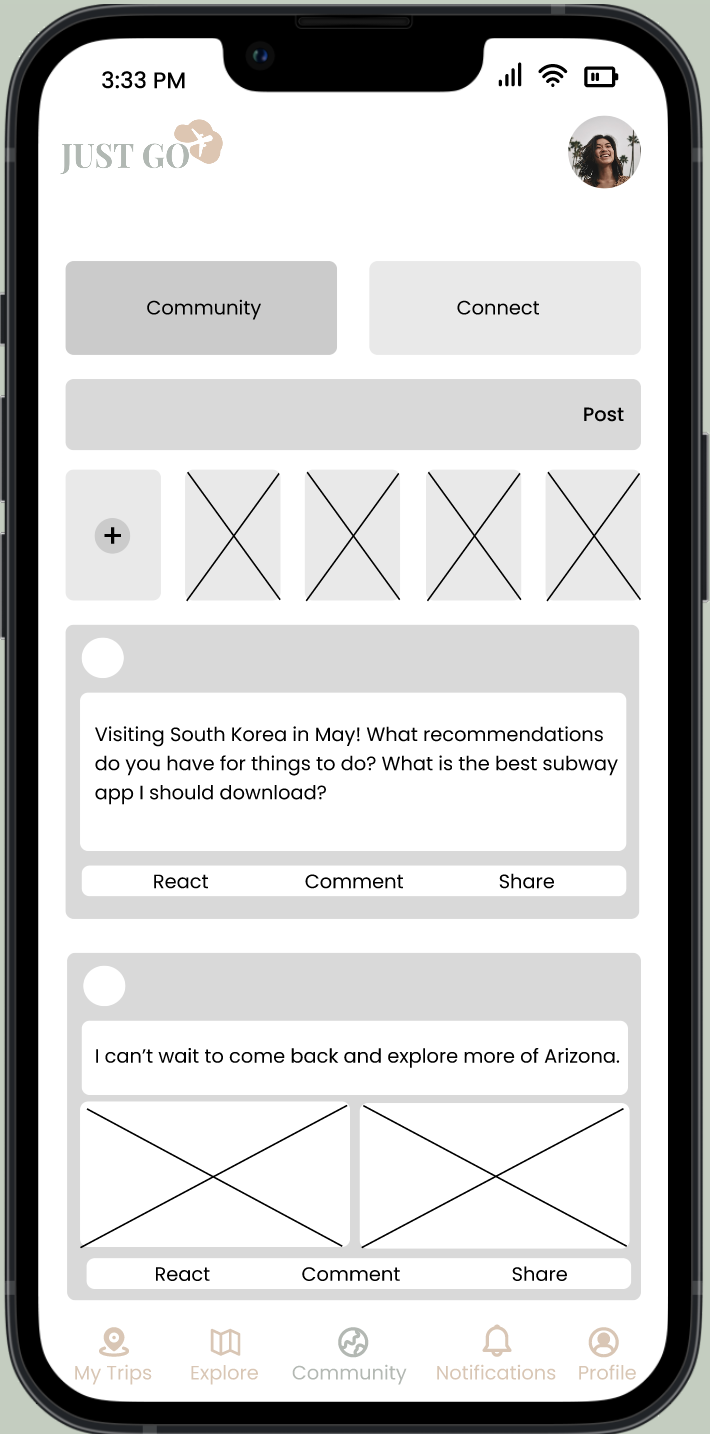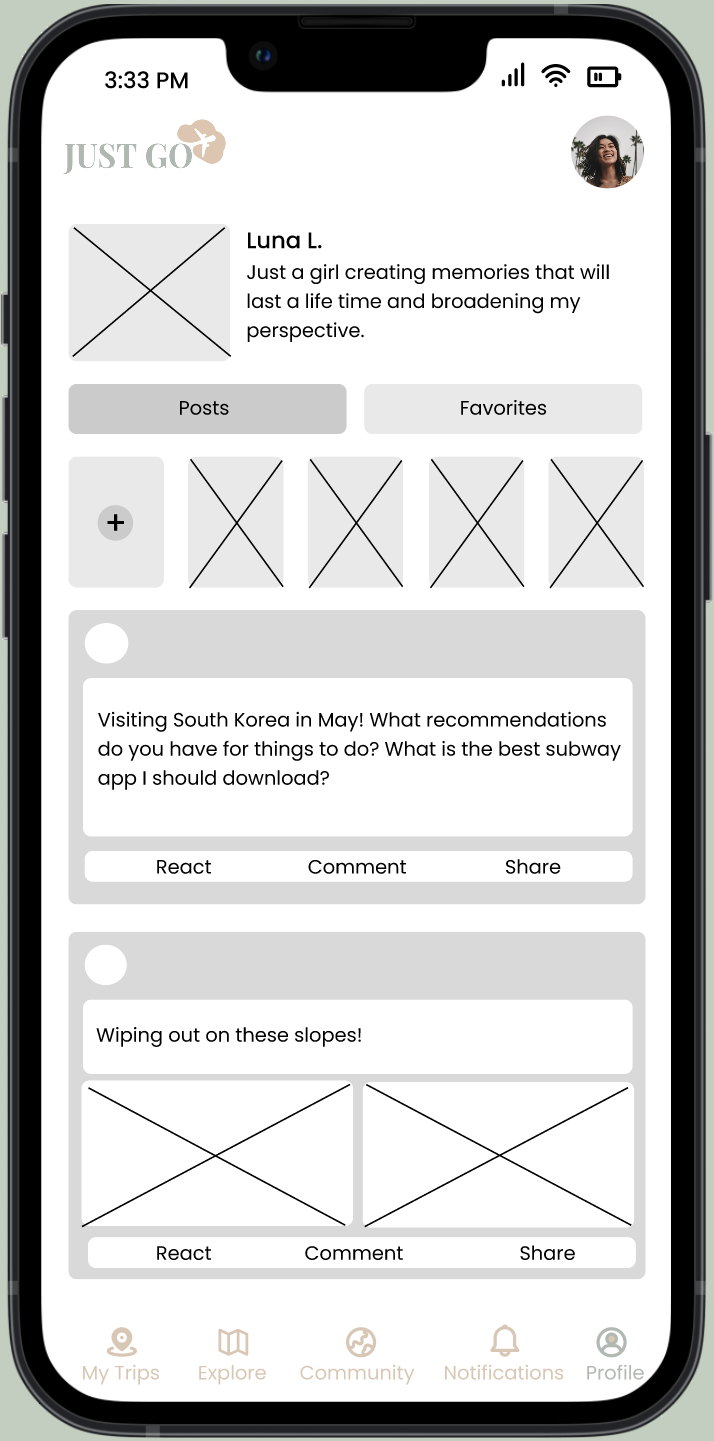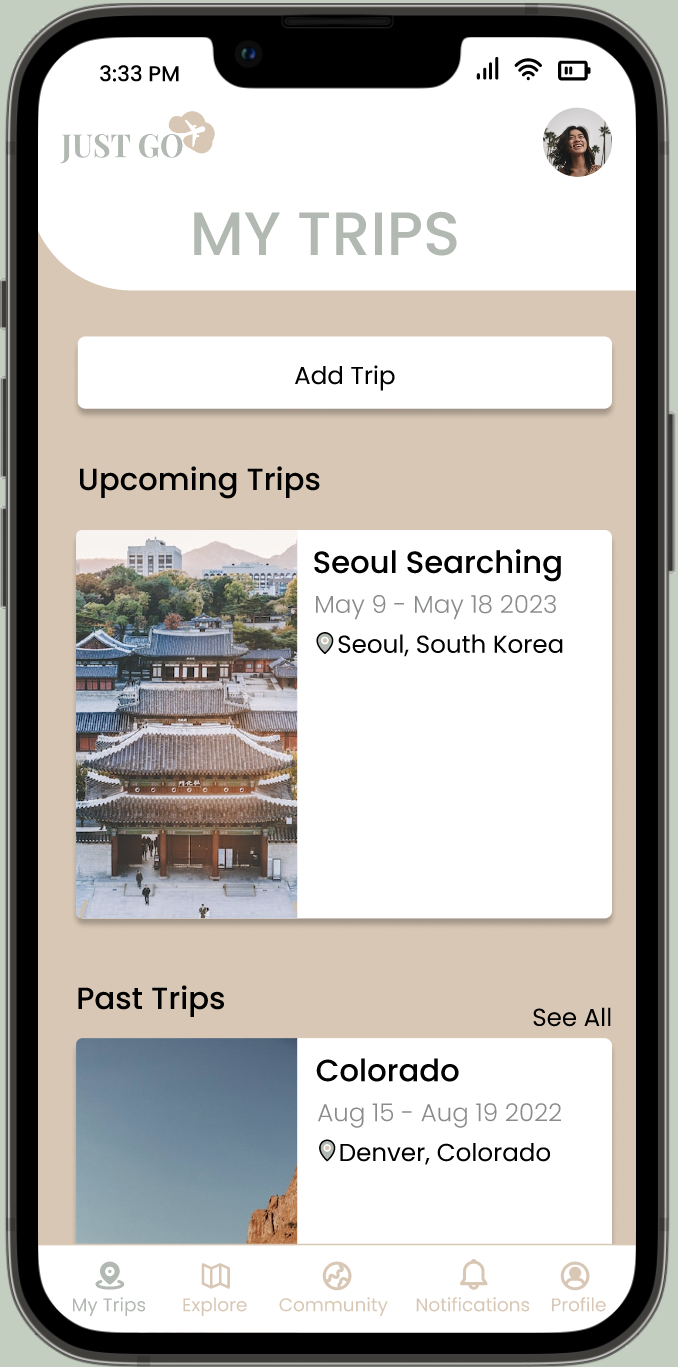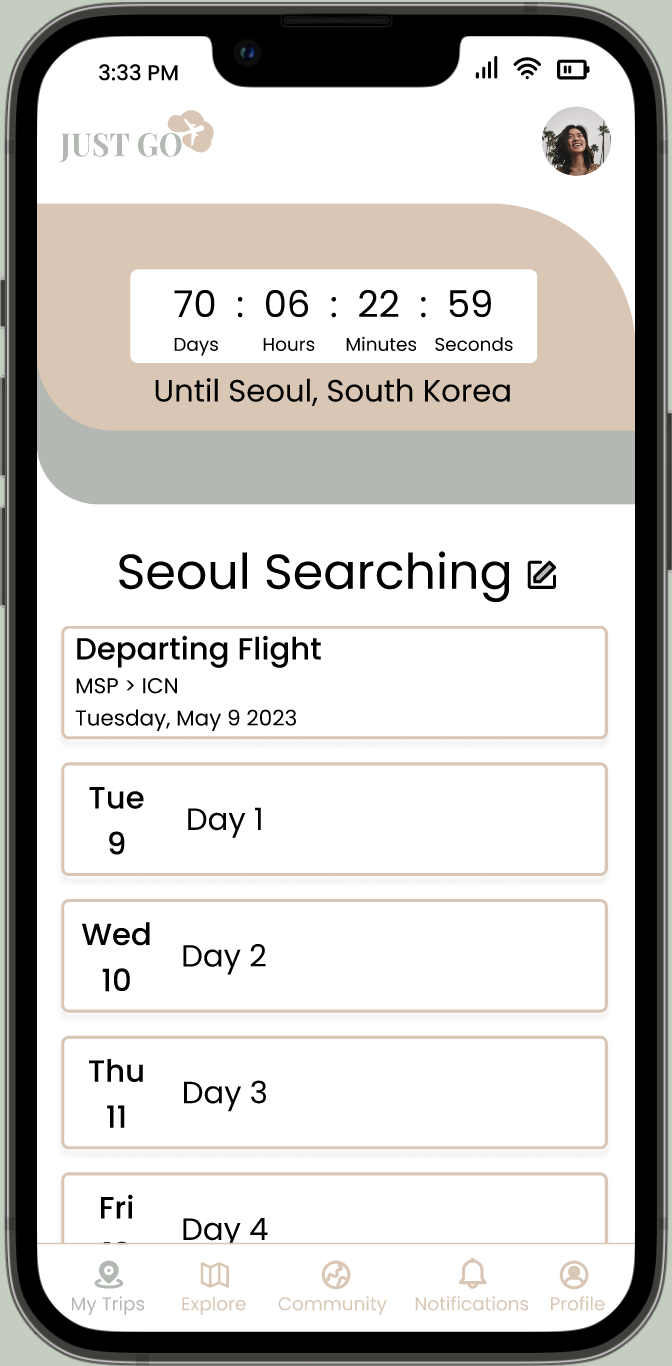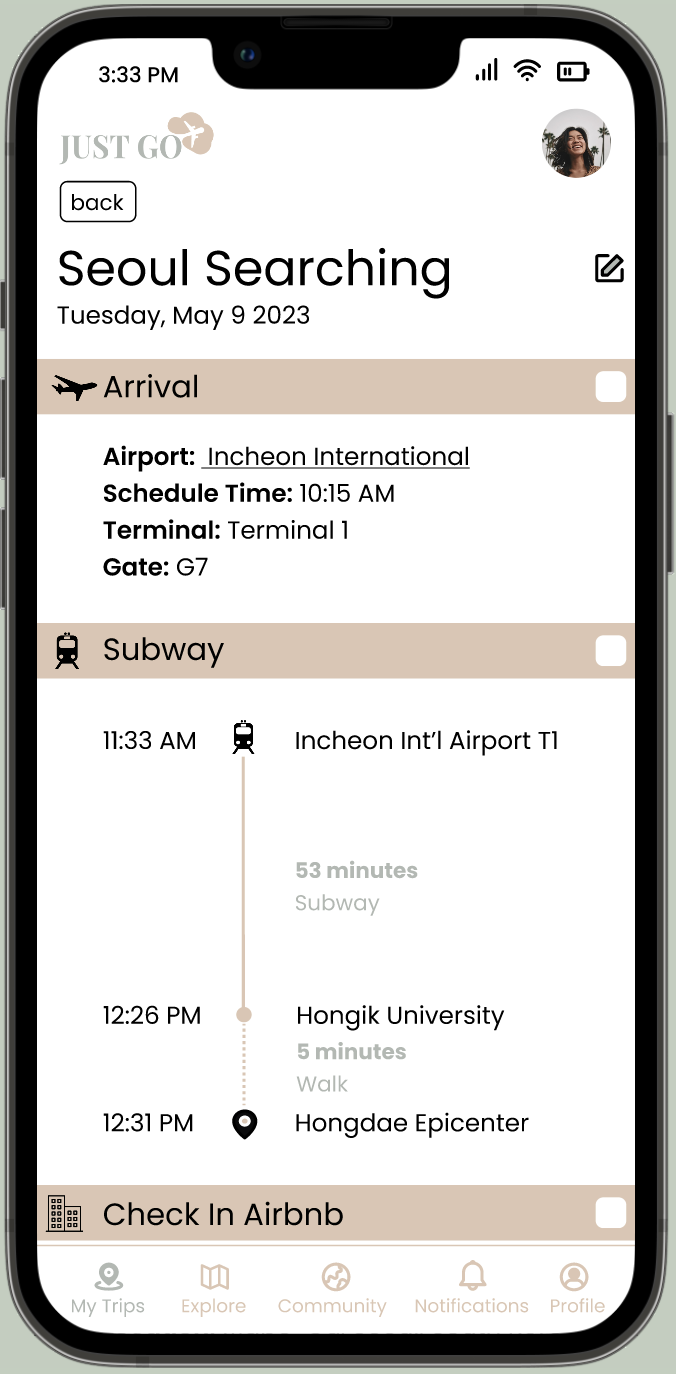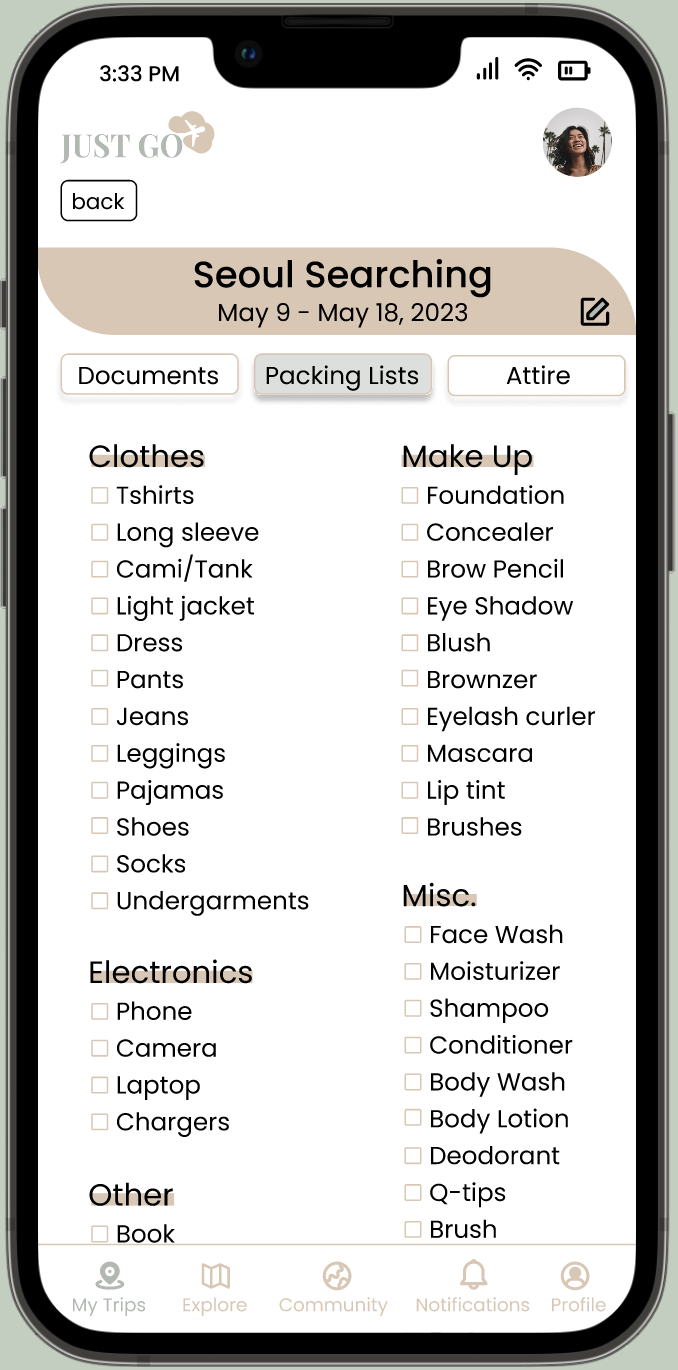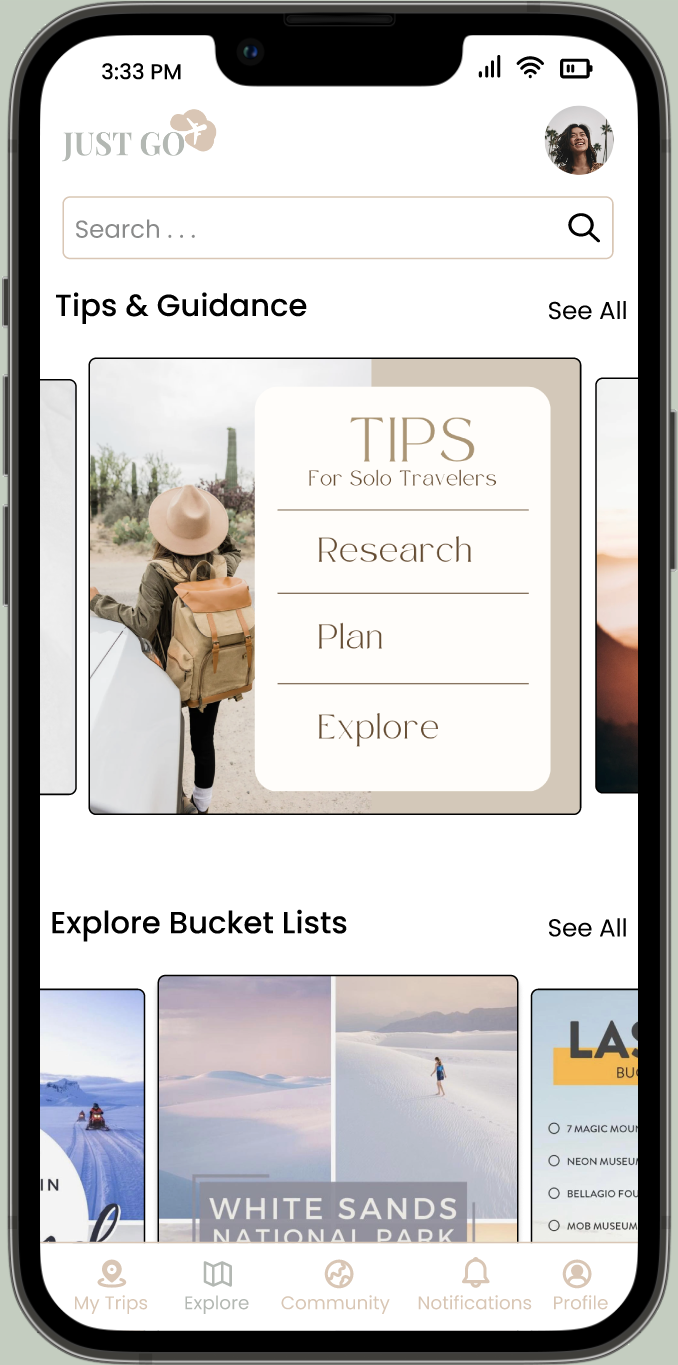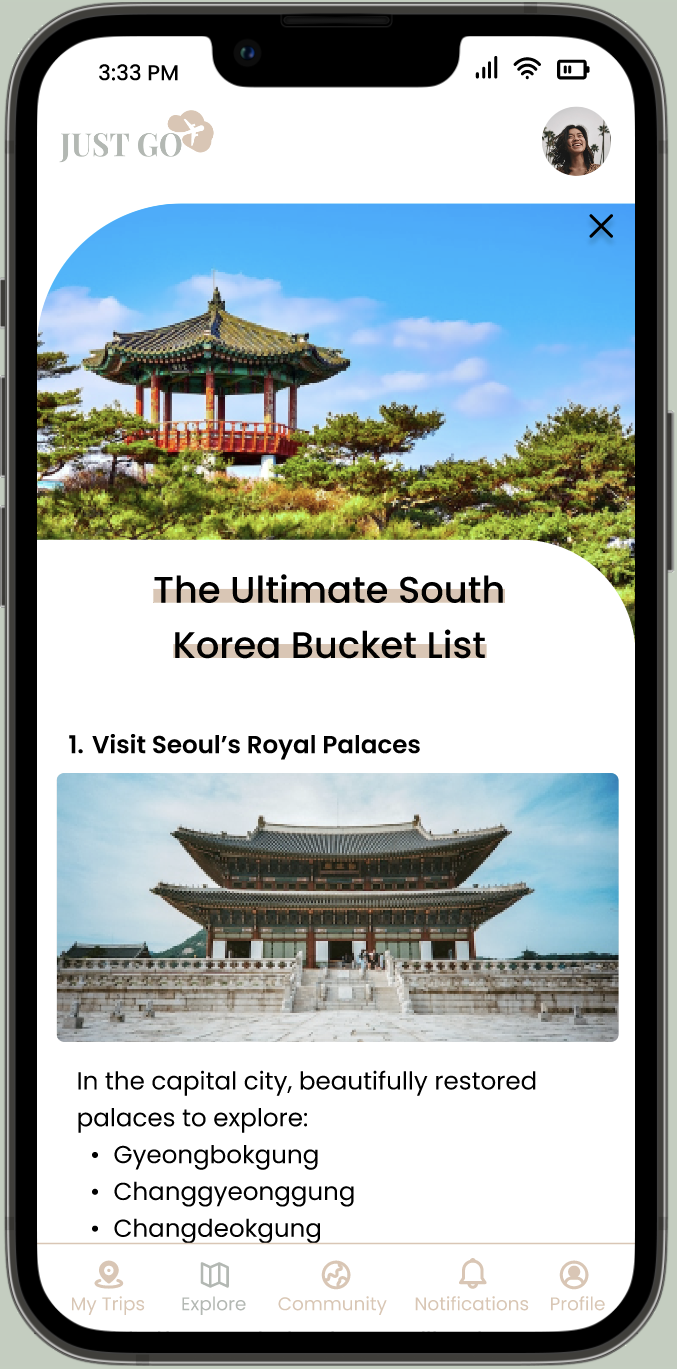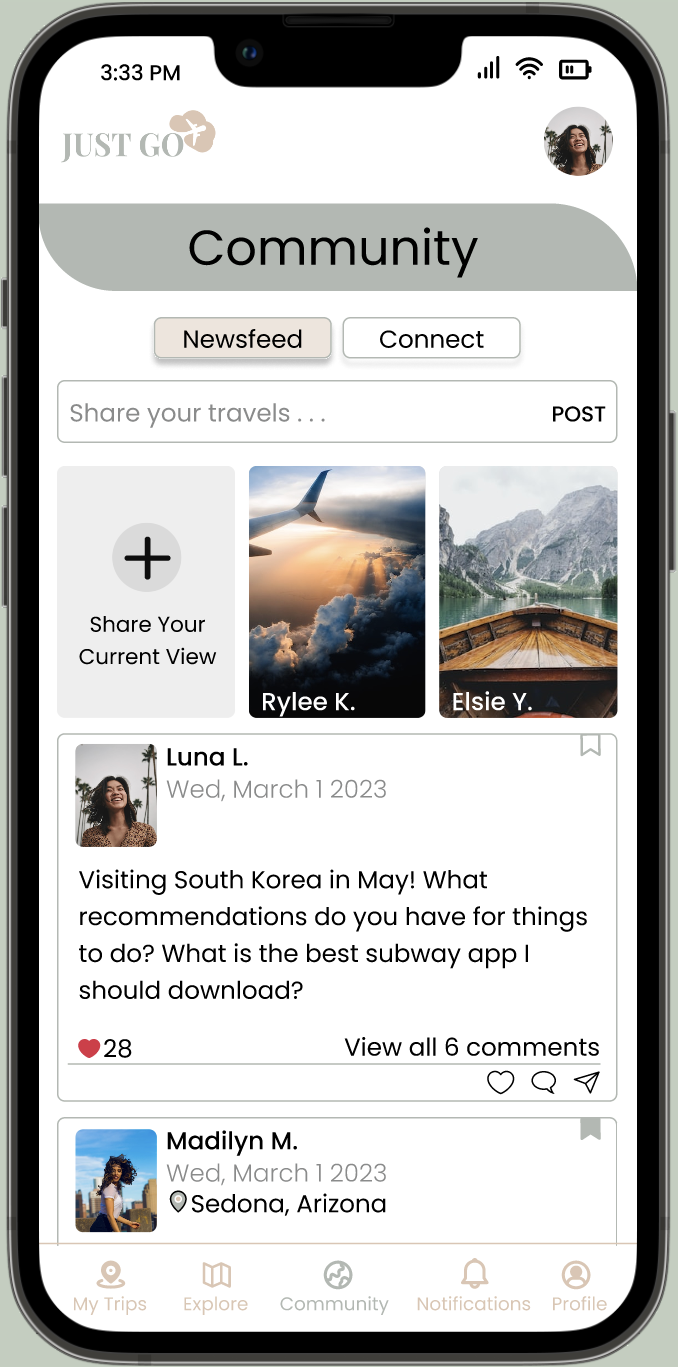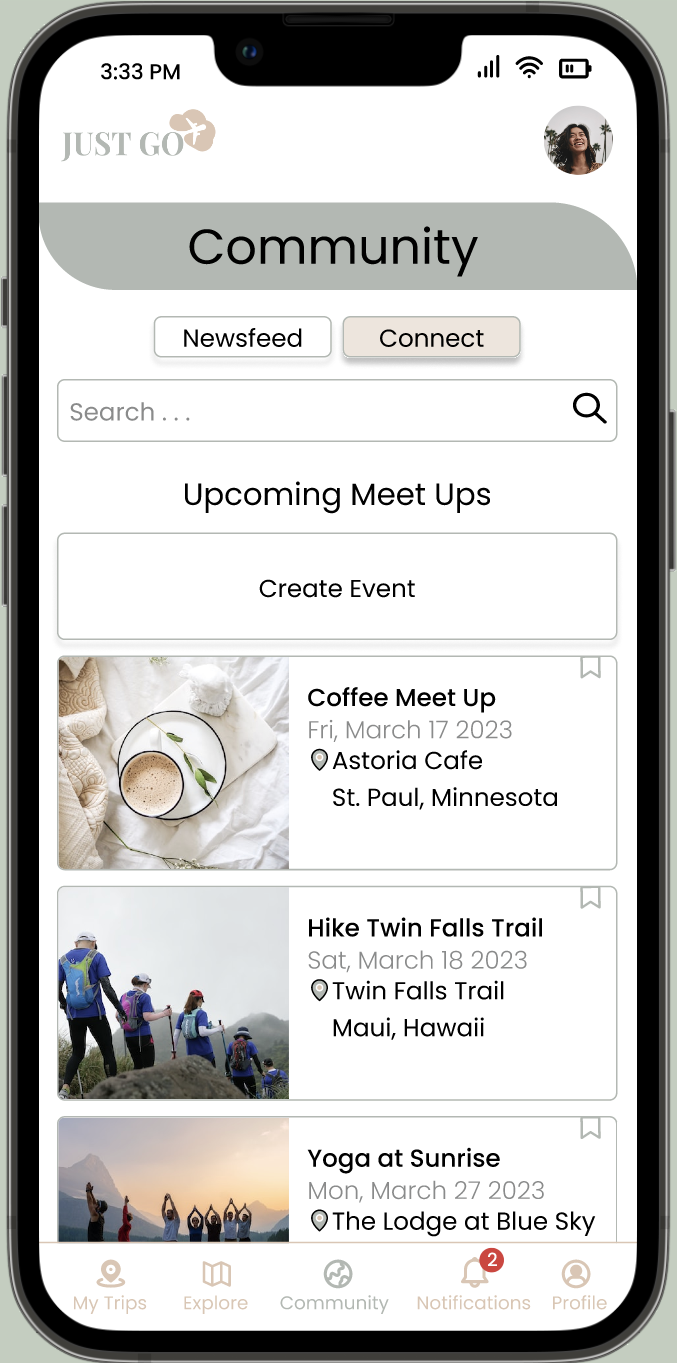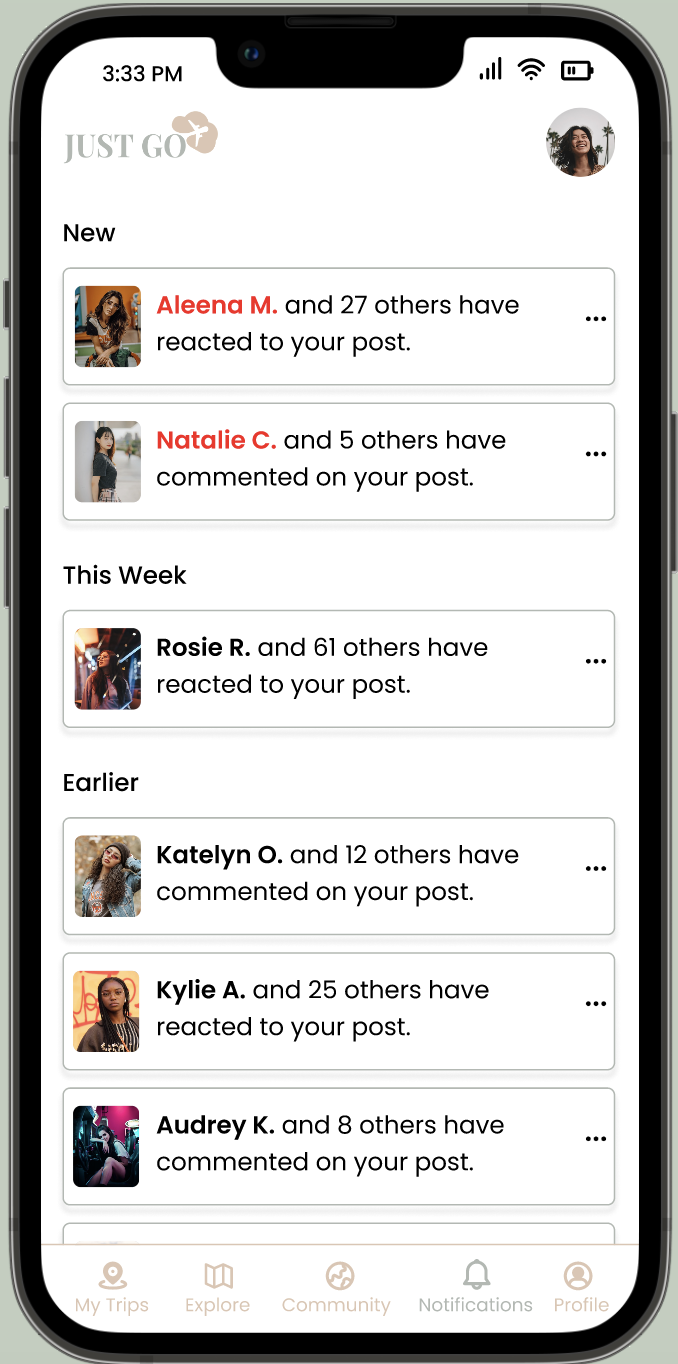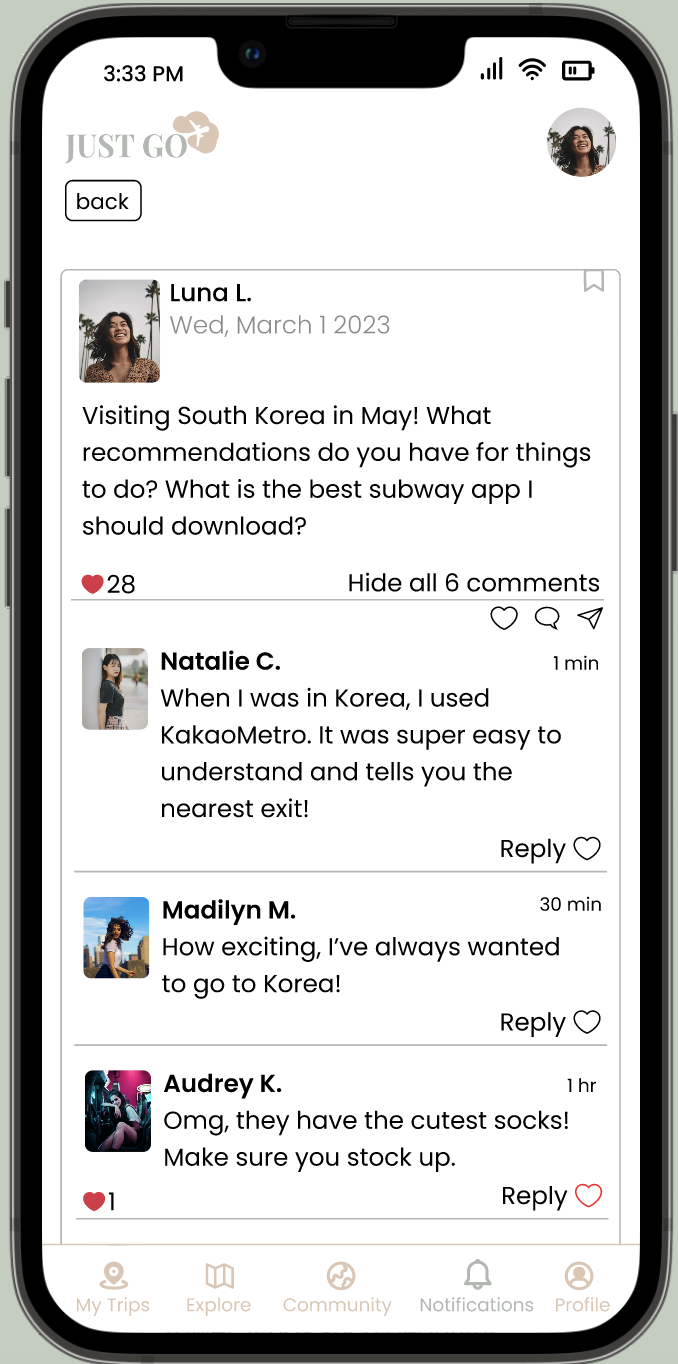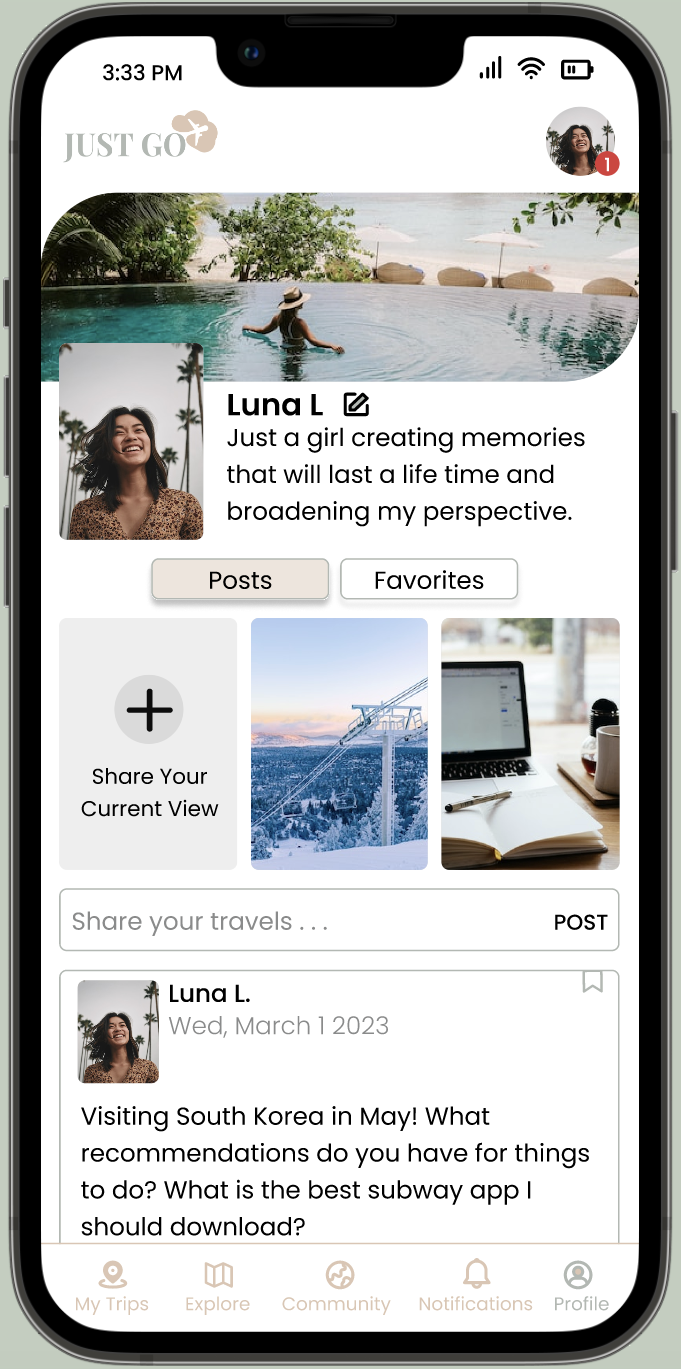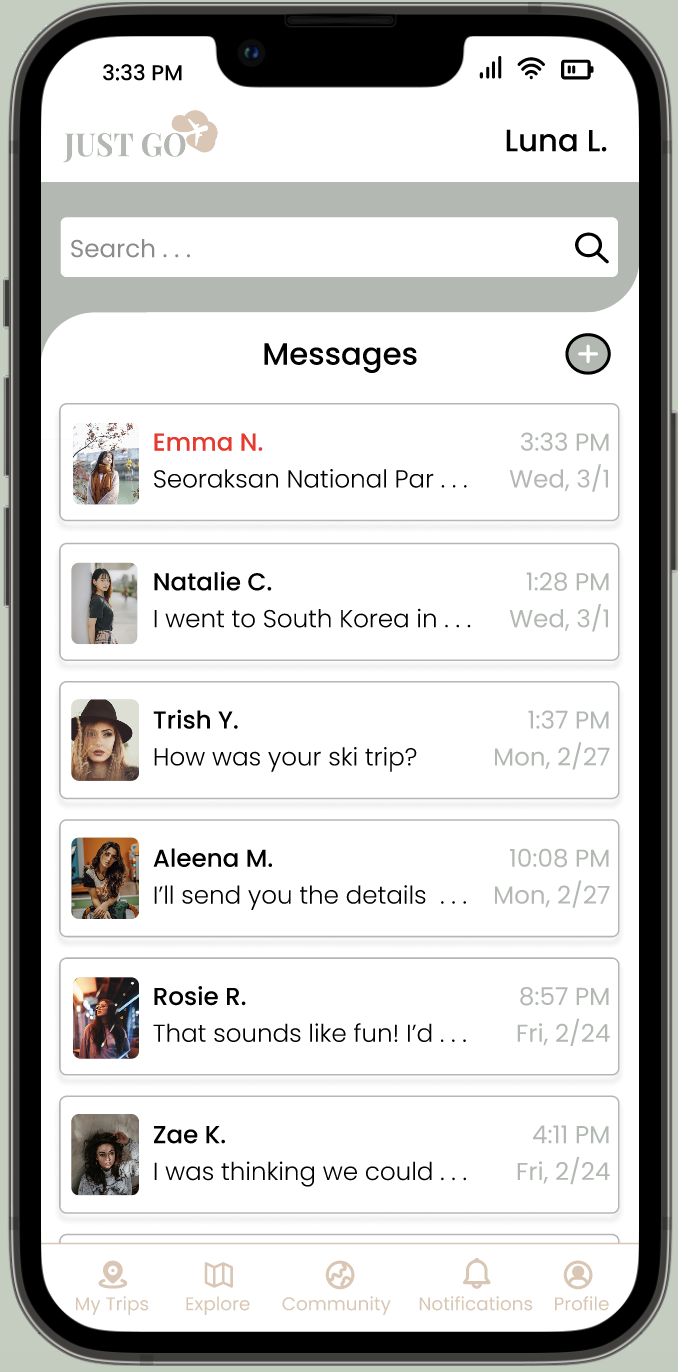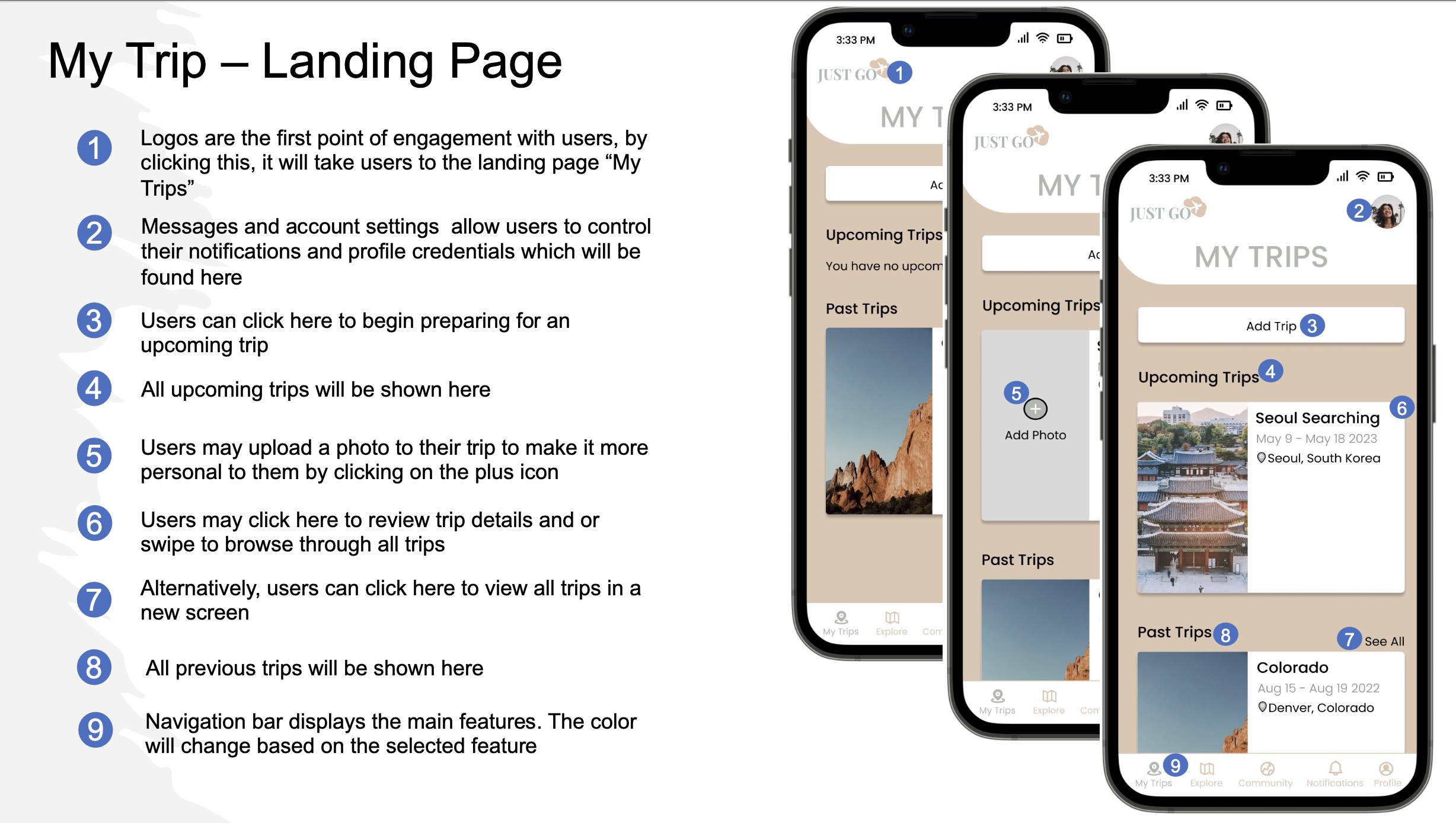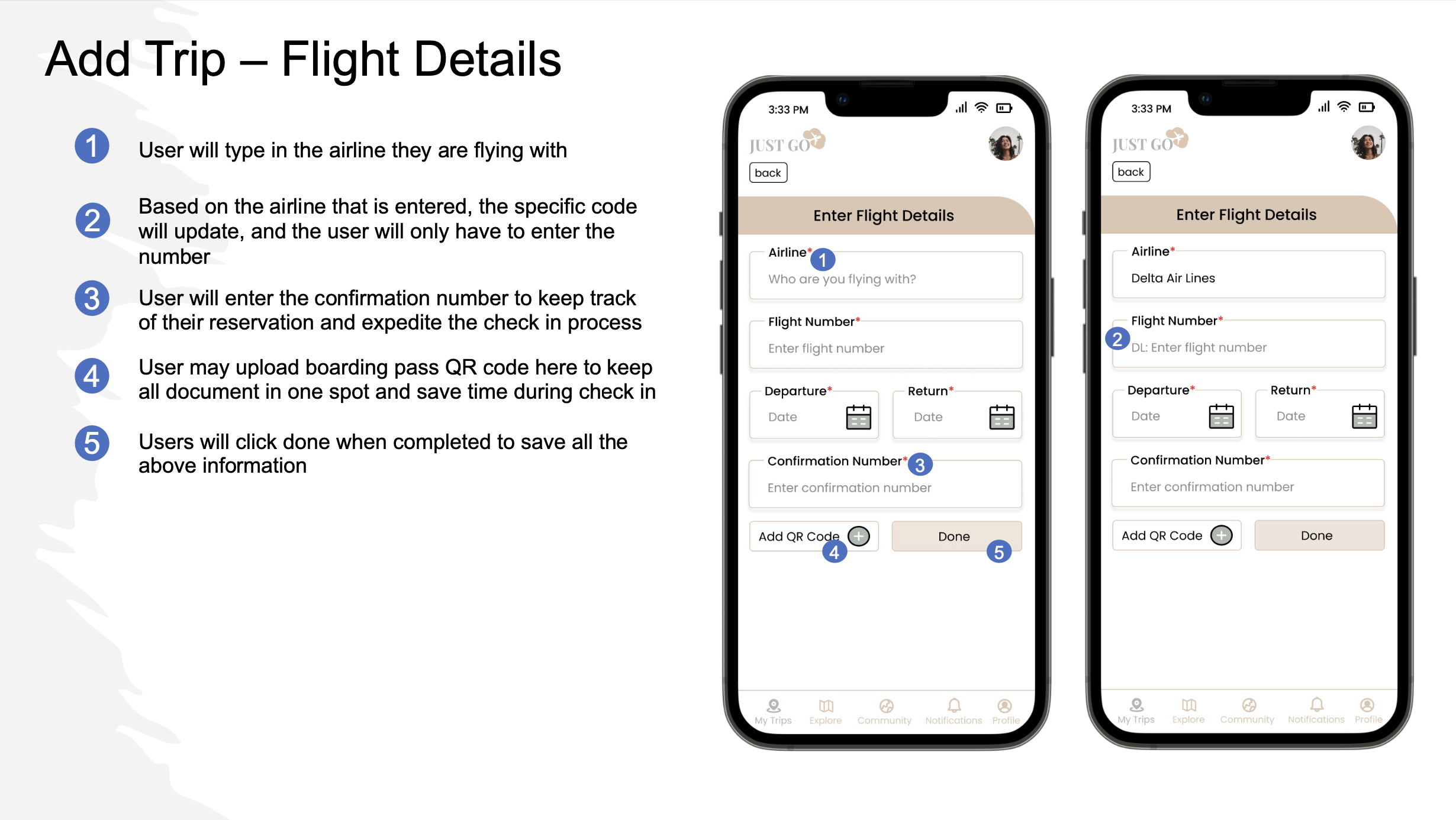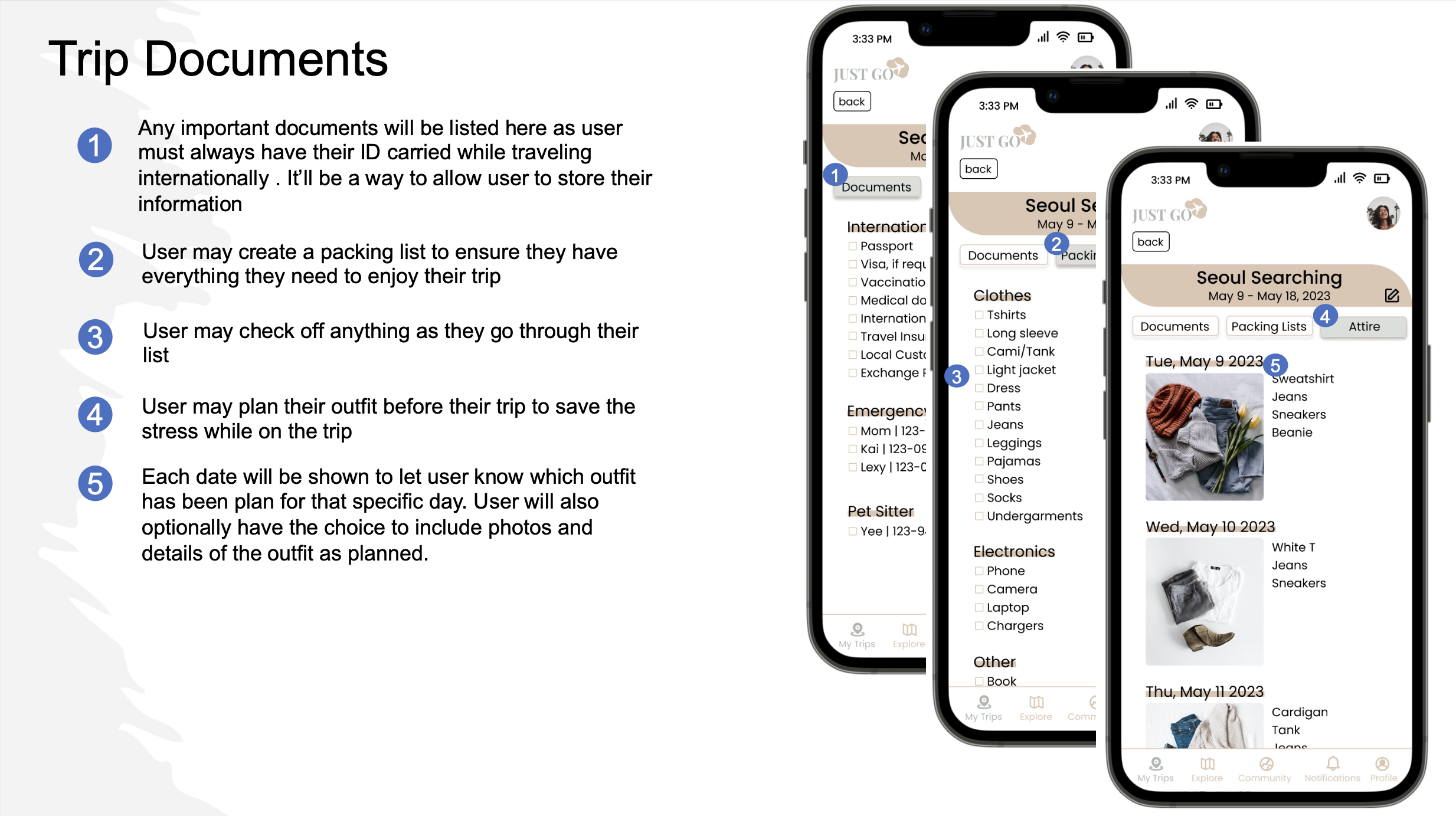Just Go
Just Go ensure the well-being of Solo Female Travelers as they prepare for their trip, connect with others, and receives tips and recommendations that enhances the unique experiences that they will be embarking on. It encourages solo female travelers to explore new destinations and experiences with a supportive and enriching community.
Overview:
Solo Traveling can be empowering and challenging as it offers unique experiences for personal growth, adventure, and a chance to reinvent yourself. You have the freedom to do what you want, when you want, and set your own itinerary with spontaneous decisions without having to worry about anyone else but yourself. You’re able to connect with yourself on a deeper level where you can gain self-confidence and discover new goals.
However, solo traveling does come with many challenges and safety concerns, especially for female solo travelers. Women who travel alone should be aware of any cultural norms, tips about the city, and learn how to take precautions of their surroundings. It would be important to do some research before taking any trip, gather any tips about the city they are visiting, recommendations where to stay or eat, and also connect with other solo female travelers for either support or inspiration.
Solutions:
With proper planning and safety precautions, women can confidently solo travel and explore the world, make new memories, and meet new people.
To prevent any potentially dangerous situation, it would be important for solo female travelers to do their research to prepare for any upcoming trips and familiarize themselves with the culture and customs of the destination. Creating a safe community to ensure the safety and well-being of solo female travelers will enhance the unique experience and mitigate potential risks through recommendations, providing tips, and understanding precautions.
This can be achieved through a mobile app where other solo travelers can share their journeys and offer advices from transporation, lodging, and cultural ettiquette. It’s a platform to connect with one another which will continue to add onto the fulfilling and transformative experience a solo traveler will embark on. It will also provide a space where solo female travelers can build out their itenery day by day.
Tools:
Zoom
Figma
Figjam
Canva
Notebook/Sketches
Pen and Pencil
Powerpoint
Methods:
Generative Research
Directed Storytelling
Comparison Analysis
User Journey Map
Information Architecture Diagram
Wireframe Flowchart
Sketch
Interactive Prototype
Usability Test
Think Aloud Protocol
Annotation
Role:
UX Design & Research
Solo Project
Solo traveling offers such a unique experience as it’s a chance to reinvent and connect with yourself in a deeper level.
As I continue to dive into this, I found that not only does a traveling app provides easy access to information and recommendations, but it can also offer a sense of encouragement and enhance the traveling experience.
Initial Research
Before diving in, I wanted to lay out what my research will involve and my first few focus was on:
Understanding primary users’ needs
How are primary users preparing for their trips
Who do you users connect with
What do users look for when preparing for a trip
Where do users share their experiences
Are there any platforms users are currently using
I then begin doing generative research to gain a deeper understanding of the users, their experiences, and what I could do to enhance their experiences. Unfortunately, female solo travelers are at higher risks of experiencing gender-based violence such as sexual assault or harassment as they are seen as an easy target for theft and robbery.; therefore, taking safety measures can help reduce any potential risks.
Discovery
I interviewed four users through directed storytelling who has either solo travel before or has the desire to but did not due to their concern of traveling alone. Solo traveling is a chance for users to get out of their comfort zone and develop a greater sense of self-confidence. Without any distraction, they are able to experience life in a deeper and more meaningful way. And lastly, it gives them a sense of encouragement that they are capable of anything they set their mind to.
However, traveling alone as a female requires for one to take extra precautions of their surroundings, extra research on their destination, and understanding safe accommodations and culture norms.
What are the experiences?
Key Findings:
4/4 finds that using a traveling app would help them better plan for their trip
4/4 travelers rely on their phone when on vacation
4/4 express it can be a hassle planning for a solo trip
4/4 spends a lot time researching and wish for it to be easier
3/4 expressed the trip has always had a better turn out than expected
3/4 get inspired by other solo travelers
1/4 express her anxiety gets the best out of her which is why she never went through with her bookings
4/4 would like to have an app that has everything in one spot
Travel plans
Recommendations
Tips and tricks
Connections
Language translator
Currency converter
I initially had planned to complete a competitive audit with what already exist; however, this became a blocker to me as I was not able to get access to join other solo female traveling platforms. Due to the process it took to get approve for this, I decided to complete a comparison analysis with similar traveling app and the type of feature they provide to help me understand what is working well and what could be improved or included. I wanted to understand the trends and best practices in the traveling market.
Through the comparison analysis, I was able to pinpoint meaningful insights and make informed decision on different trends and patterns. By weighing the pros and cons, it helped me decide on what the desired functionality and performance I wanted to focus on as I identified features that were either missed or could be improved. This analysis helped me determined what was necessary to provide a positive user experience.
Challenge
Feature Compairison Analysis
The Process
To best understand the user needs, I created a user journey map to identify any pain points that led me to create a design that will align with my user’s goals. I began visualizing the user experience and understood the flow of interactions of what currently exist. This help me understand what areas I wanted to focus on and where improvements are needed to enhance the user experience. Through this process, I continued to measure the success of my design through usability testings. By tracking their interactions, it led me to the future state of the desired user experience. The purpose of this was to understand how I can identify what areas are needed for attention.
Journey
Current State
Currently, users find it overwhelming to plan for their trips and are unsure where to even start. They have many questions about the challenges and their safety concerns.
Future State
With new opportunities, users has a safe community to connect with others, share their experience, receive tips and recommendations, and properly plan for their trips.
Before I began sketching, I created an information architecture diagram to help structure the overall system and design an effective navigation system that will be easy to understand. My main objective was to ensure the scalability and user-friendly system were considered.
Flow
In order to ensure consistency in the design decisions, I created a wireframe flowchart which laid out the app’s structure and functionality. By doing so, I gained a clear understanding of what aspects of the design needed to be prioritize. By keeping my user’s needs throughout the design process, I was then able to identify and define the user flow and interactions.
Once I identified the primary features, I proceeded to brainstorm and explore various design solutions, generating ideas and sketching them out. As I explored different variations, I eventually came upon a solution that I would like to move forward that felt most promising and proceeded to convert them into mid-fidelity digital wireframes for usability testings.
Sketching
Testing
To validate my design concepts, I developed an interactive prototype and conducted usability testing using the Think Aloud Protocol to gather feedback from users. This approach enabled me to gain valuable insights into the areas where the design could be improved to better meet their needs. Through this, I was able to identify any pain points, confusion, or issues that they may have encountered with the mid-fidelity wireframes. This feedback was essential as I move forward to refining the design.
Now that I received direct feedback from users, I went back to the drawing board and sketched out a new feature to “Add Trip” to better meet my user’s needs. My focus was on user-center designed and to ensure I implemented the feedback that will be more efficient and improve user’s satisfaction.
Feedback
Key Findings:
Some UI elements and text were difficult to read and not easily understandable
There was lack on consistent content with the resources screen
3/4 participants were interested to see how “Add Trip” would interact
3/4 Participants liked the different features the app offered
3/4 Participants expressed a positive experience
4/4 Participants found the app to be easy to navigate and had a clear interface
4/4 Participants liked being able to customize their trip
4/4 Participants appreciate connecting with others and the social feed
Mid-fidelity Wireframes
Based on the feedback that I received during the usability testing, I had made some adjustments to the existing design to ensure the wireframes are as accurate and effective as possible to meet the user’s needs. I continued to implement their suggestions and built it out to an high fidelity interactive prototype that provides a more realistic representation of the design with an aesthetic look. The biggest refinements I had to make was enlarging the fonts and images to ensure my designs are accessible to all users.
I then did another round of usability test with the high fidelity interactive prototype.
Refining
User’s Impressions:
“I really like the color scheme! It’s calming. The chat function on the app would be so great for groups!”
“I love the idea. I also like the look and feel of the app, seems intuitive!”
“I like how each day has an agenda and provide different options, also love the color choice. I would use this on my next adventure.”
“The layout is consistent and very easy on the eyes. I really like it, super easy to understand and is user-friendly.”
High-fidelity Wireframes
By providing wireframe annotations, I was able to clarify and document the design decision I made during the design process. This ensures that the final product will accurately reflect the needs of users which was identified through my research.
Watch My Presentation
Key Takeaway
Through a user-center design approach, I developed an interactive prototype with a thorough understanding of the user’s goals and challenges. With this process, I ensured I considered the user’s goals throughout every step as my focus was to design interfaces that were intuitive and easy to use and by gathering feedback from users, I was able to make the necessary improvements and refinements to my design that met the users’ satisfications. It was also extremely important to find the right participants to gain valuable insights through the usbability testings.
Going forward, I’d be interested in exploring extra features such as adding a currency converter or language translator to the app and interviewing users if this is diserable. I’d also like to expand more on how to personalize the planning aspect of the trip and perhaps touch on how it can also target group female travelers. From there, I’d continue to do another round of usability testing in working my way to make further improvements.

